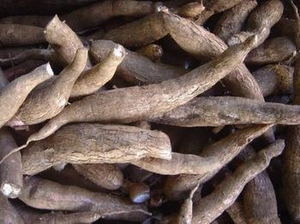 ording to the FAO – the Food and Agriculture Organisation of the United Nations - Save and Grow, an environmentally-friendly farming model can sustainably increase cassava yields by up to 400% and help turn this staple from a poor people's food into a 21st century crop.
ording to the FAO – the Food and Agriculture Organisation of the United Nations - Save and Grow, an environmentally-friendly farming model can sustainably increase cassava yields by up to 400% and help turn this staple from a poor people's food into a 21st century crop.In a newly-published field guide detailing Save and Grow's applications to cassava smallholder production, FAO noted that global cassava output has increased by 60% since 2000 and is set to accelerate further over the current decade as policymakers recognise its huge potential.
But using the inputs-intensive approach pioneered during last century's Green Revolution to boost cassava production risks causing further damage to the natural resource base and increasing the greenhouse gas emissions responsible for climate change, the organisation said.
The solution, says FAO, lies in the Save and Grow approach which achieves higher yields with improved soil health rather than with the heavy use of chemical inputs.
Save and Grow minimises soil disturbance caused by conventional tillage such as ploughing, and recommends maintaining a protective cover of vegetation over soil.
Instead of the monocropping normally seen in intensive farming systems, Save and Grow encourages mixed cropping and crops rotation, and predicates integrated pest management, which uses disease-free planting material and pests' natural enemies to keep harmful insects down, instead of chemical pesticides.
The approach is said to have yielded spectacular results in trials organised in Vietnam, where farmers using the improved technologies and practices boosted cassava yields from 8.5 tonnes to 36 tonnes -- an increase of more than 400%.
In the Democratic Republic of Congo, through training in the use of healthy planting materials, mulching and intercropping, farmers attending field schools achieved yield increases of up to 250%.
In Colombia, rotating cassava with beans and sorghum restored yields where mineral fertiliser alone had failed.
Cassava is a highly versatile crop grown by smallholders in more than 100 countries. Its roots are rich in carbohydrates while its tender leaves contain up to 25% protein, plus iron, calcium and vitamins A and C. Other parts of the plant can be used as animal feed, and livestock raised on cassava have good disease resistance and low mortality rates.
One reason driving increased demand for cassava is the current high level of cereal prices, said the FAO. This makes it an attractive alternative to wheat and maize, particularly as cassava can be processed into a high-quality flour than can partially substitute for wheat flour.
But, together with its importance as a source of food and food security, cassava also has a range of industrial uses that give it huge potential to spur rural industrial development and raise rural incomes.
Cassava is second only to maize as a source of starch and recently-developed varieties produce root starch that will be highly sought after by industries. Demand for cassava as a feedstock for the manufacture of bioethanol is also growing rapidly.
Another important consideration is that of the major staple crops in Africa, hardy, resilient cassava is expected to be the least affected by advancing climate change.
With Save and Grow developing countries can thus avoid the risks of unsustainable intensification while realising cassava's potential for producing higher yields, alleviating hunger and rural poverty and contributing to national economic development, the FAO concluded.





